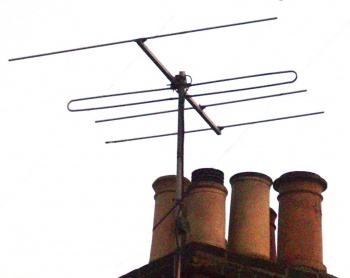VHF aerial
FM radios can give much better reception and often more channels if connected to an aerial.
UK FM radio is transmitted on VHF frequencies, so the terms FM and VHF are often used interchangeably.
VHF Aerial types
4 element FM aerial
Shown above, these are the best performers for VHF reception. They're directional and need to be pointed toward the main transmitter, random orientation gives middling results.
VHF / UHF aerial
A small number of TV aerials are designed to give VHF reception as well as UHF. These aerials are easily spotted, they look like standard TV aerials, but have one or 2 elements that are much longer than the others.
These give significantly better VHF reception than UHF only TV aerials, though performance is inferior to a dedicated VHF aerial. The advantage of these is you only need one aerial, one downlead and no combiner.
UHF TV aerial
UHF TV aerials make very variable quality VHF FM aerials, but they're often much better than internal VHF antennas, telescopic rods, or the popular rabbit's ears, and most people already have a TV aerial fitted. If you've decided not to spend money on a VHF aerial, in many cases you can get a real improvement in FM reception by using a diplexer at the radio to split off any VHF received by the TV aerial and pass that to the radio.
Performance varies from one TV aerial type to another, and a random UHF aerial may give anything from no signal to a good signal. The good news is that to test a TV aerial's usefulness, all you need do is plug it into the FM radio temporarily. (It shouldn't be left that way, doing so can impair or block tv reception.)
Halfwave dipole
Very good
Folded dipole
Good.
Halo
A ring shaped omnidirectional antenna, these are very common. Less gain than directional types, but can still often produce a good signal.
Rabbits ears
A T shaped piece of twin wire is widely, albeit incorrectly, known as a rabbit's ears antenna. The ears are moved about to sometimes get passable reception, and typically fixed to the wall with a blob of tack.
These aren't good aerials, but at least they're an improvement on a random piece of wire.
Telescopic rod & Wire
Telescopic metal rods and lengths of wire are the lowest performance VHF aerials. However they're often built into radios as they cost so little.
Sometimes the reception of a wire aerial can be improved by snaking it round the mains lead for capacitive coupling.
Mains aerial
The electricity mains is sometimes used as an aerial. This is done by fitting a very low value high voltage class Y capacitor from to aerial connection. These give more signal than a wire aerial wrapped round a lead, but are prone to interference.
A 1nF 250v ac class Y capacitor works nicely, with an rf reactance of about 1.7 ohms.
If the wrong capacitor type is used it creates a risk of electrocution. Any of the following can create this risk:
- wrong capacity (eg 0.22uF)
- wrong voltage rating (eg 250v or 400v)
- wrong class (eg unclassed, class X)
- wrong dielectric type (eg paper) (Class Y caps never use the wrong types of dielectric)
